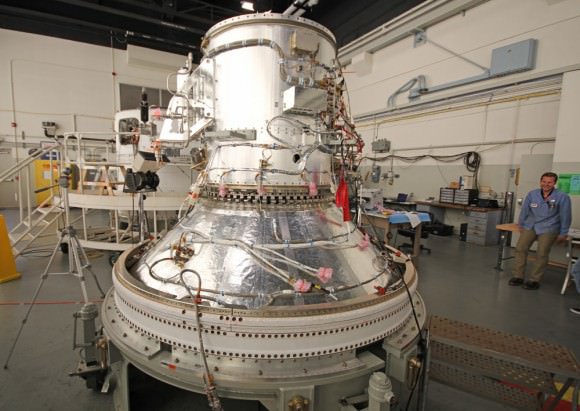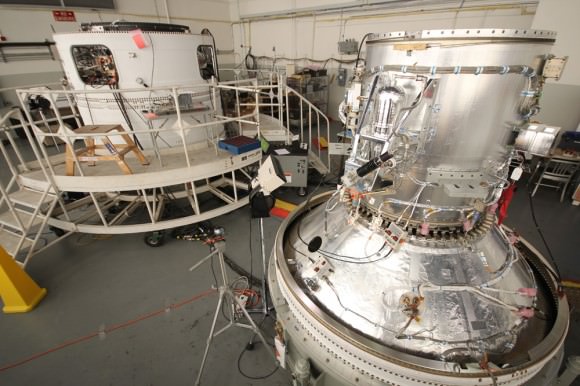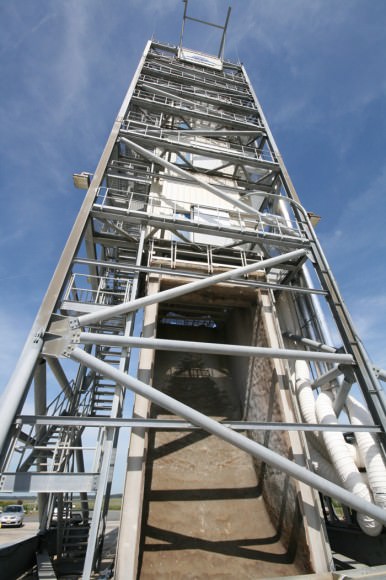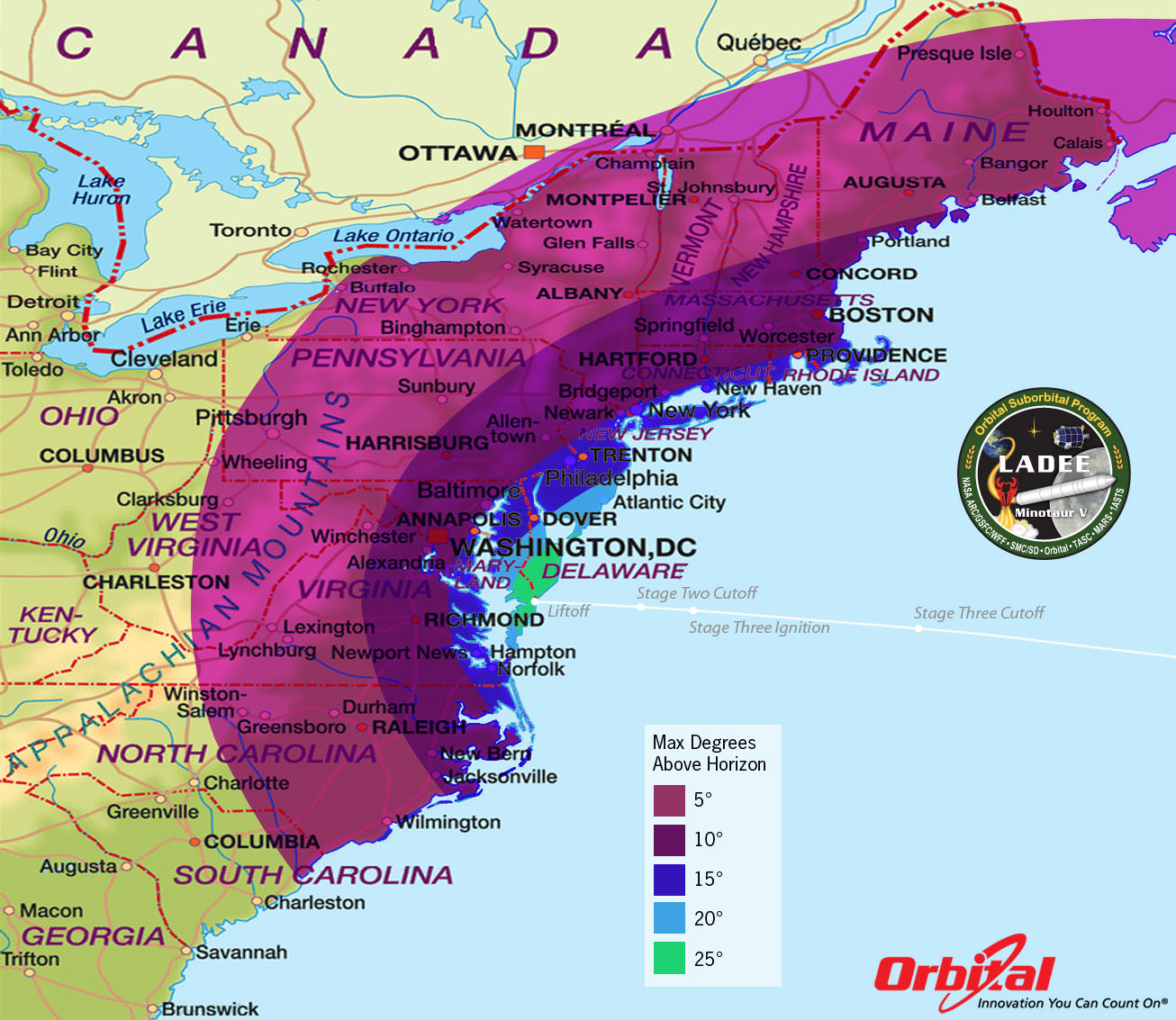LADEE Minotaur V Launch – Maximum Elevation Map
The LADEE nighttime launch will be visible to millions of spectators across a wide area of the Eastern US -weather permitting. This map shows the maximum elevation (degrees above the horizon) that the Minotaur V rocket will reach during the Sep. 6, 2013 launch depending on your location along the US east coast. Credit: Orbital Sciences [/caption]
A spectacular nighttime blastoff blazing a historic trail to the Moon is set to soar in two weeks time when NASA’s LADEE spacecraft lifts off from the Eastern Shore of Virginia at NASA’s Wallops Flight Facility on Wallops Island – from America’s newest spaceport.
NASA’s Lunar Atmosphere and Dust Environment Explorer (LADEE) Observatory will thunder to space at 11:27 p.m. Friday, Sept. 6, from the commercial Mid-Atlantic Regional Spaceport (MARS) launch complex 0B at NASA’s Wallops Island facility atop the maiden flight of the new, solid fueled Minotaur V rocket developed by Orbital Sciences Corp.
LADEE’s late night launch will be absolutely spectacular and visible to tens of millions of spectators up and down the US East coast and interior areas stretching into the Midwest- weather permitting.
“I love this mission,” said John Grunsfeld, NASA Associate Administrator for Science at NASA Headquarters, at a media briefing today, Aug. 22.

Close-up view of STAR 37 5th stage solid fuel motor for inaugural Minotaur V rocket launch at NASA Wallops rocket facility will propel LADEE into its lunar transfer orbit. LADEE will be mounted on top and surrounded by the payload fairing attached at bottom ring. Credit: Ken Kremer/kenkremer.com
“With NASA’s prior LRO and GRAIL spacecraft we studied the Moon’s surface and interior. Now with LADEE we study the atmosphere and dust,” said John Grunsfeld.
The purpose of LADEE is to collect data that will inform scientists in unprecedented detail about the ultra thin lunar atmosphere, environmental influences on lunar dust and conditions near the surface. In turn this will lead to a better understanding of other planetary bodies in our solar system and beyond.
The small car sized LADEE lunar orbiter mission will be historic in many ways. It’s the first probe of any kind ever launched to beyond Earth orbit from NASA Wallops, as well as being the first planetary science mission from Wallops.
It also marks the first launch of a five stage rocket and the first launch of a decommissioned Peacekeeper missile from Wallops.
The first three stages of the Minotaur V are based on the nuclear armed Peacekeeper ICBM intercontinental ballistic missile built during the Cold War – now retired and refurbished by Orbital for peaceful uses. Its literally beating sword into ploughshares.
The 5th stage is a new addition and what makes this Minotaur a new rocket class. The added thrust is precisely what enables shooting for the Moon.
Recently, I had an exclusive tour and photoshoot up close and personal with the upper stages of LADEE’s Minotaur V rocket at Wallops prior to integration at the commercial launch pad – 0B – and will be reporting on that here and in upcoming stories.

“LADEE is equipped with three science instruments to study the atmosphere and dust and a lunar laser technology demonstration,” said Joan Salute, LADEE program executive, NASA Headquarters.
These include an ultraviolet and visible light spectrometer that will gather detailed information about the composition of the tenuous lunar atmosphere; a neutral mass spectrometer to measure variations in the lunar atmosphere over time; a laser dust experiment that will collect and analyze dust particle samples; and a laser communications experiment that will test the use of lasers in place of radio waves for high speed dad communications with Earth.
“The lunar atmosphere is so thin that the molecules never collide,’ said Sarah Noble, LADEE program scientist, NASA Headquarters.
“It’s a ‘Surface Boundary Exosphere’ which is actually the most common type of atmosphere in our Solar System.”
Scientists also hope to solve a mystery dating back nearly five decades to the Apollo moon landing era, by determining if electrically charged lunar dust is responsible for the pre-sunrise horizon glow seen by the Apollo astronauts and also by the unmanned Surveyor 7 lander, according to Noble.
“This is the first NASA mission with a dedicated laser communications experiment,” said Don Cornwell, mission manager for the Lunar Laser Communications Demonstration, NASA’s Goddard Space Flight Center, Greenbelt, Md.
I asked when we could see laser communications implemented on future NASA spacecraft?
“A new laser communications system could possibly be used on the 2020 Mars rover from the surface of Mars,” Grunsfeld told Universe Today.
The couch sized 844 pound (383 kg) robotic explorer was assembled at NASA’s Ames Research Center, Moffett Field, Calif., and is a cooperative project with NASA Goddard Spaceflight Center in Maryland.
The spacecraft is a first of its kind vehicle built from a NASA Ames-developed Modular Common Spacecraft Bus architecture that can be applied to other missions. The mission cost is approximately $280 million.
The Minotaur V will boost LADEE into a highly elliptical orbit. Then over the next 23 days, as LADEE orbits Earth 3.5 times, the Moon’s gravitational field will increase the perigee of its orbit. The spacecraft will fire its on-board braking thrusters to achieve lunar orbit.
NASA Ames LADEE Mission – Lunar Orbital Insertion Animation
Video caption: This animation is a representation of lunar orbital insertion for LADEE, which is the path the spacecraft follows when it is captured by the Moon’s gravity and enters lunar orbit. Credit: NASA Ames/Dana Berry. Note: Animation is silent with no audio/music track included.
The mission will fly in a very low science orbit of about 50 kilometers altitude above the moon. The science mission duration is approximately 100 days.
“It’s limited by the amount of onboard fuel required to maintain orbit,” Doug Voss, launch manager, Wallops, told Universe Today.
“I’m excited about the night launch because people up and down the Atlantic seacoast will be able to see it,” Jim Green, Planetary Science Division Director at NASA HQ, told me.
And don’t forget that NASA has a 2nd really big launch from Wallops slated for Sep. 17 – with blastoff of the Orbital Sciences Antares rocket and Cygnus cargo carrier on their historic 1st mission to the International Space Station (ISS).
I’ll be on site at Wallops for both historic launches on Sep. 6 and 17 – reporting for Universe Today.
We’ll see you in Virginia!
…………….
Learn more about LADEE, Cygnus, Antares, MAVEN, Orion, Mars rovers and more at Ken’s upcoming presentations
Sep 5/6/16/17: “LADEE Lunar & Antares/Cygnus ISS Rocket Launches from Virginia”; Rodeway Inn, Chincoteague, VA, 8 PM
Oct 3: “Curiosity, MAVEN and the Search for Life on Mars – (3-D)”, STAR Astronomy Club, Brookdale Community College & Monmouth Museum, Lincroft, NJ, 8 PM
Oct 9: “LADEE Lunar & Antares/Cygnus ISS Rocket Launches from Virginia”; Princeton University, Amateur Astronomers Assoc of Princeton (AAAP), Princeton, NJ, 8 PM




Why is it covered in solar cells, and the Apollo wasn’t?
The Apollo service module included fuel cells that generated electricity by reacting hydrogen and oxygen.
Because the Apollo Command/Service Module’s electrical power was provided by three fuel cells; these combined hydrogen and oxygen to not only generate electrical power, but also drinking water for the astronauts.
Prepare for incoming floods of UFO report